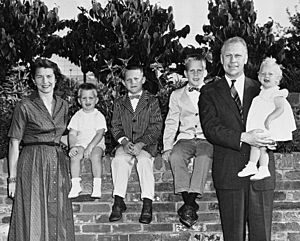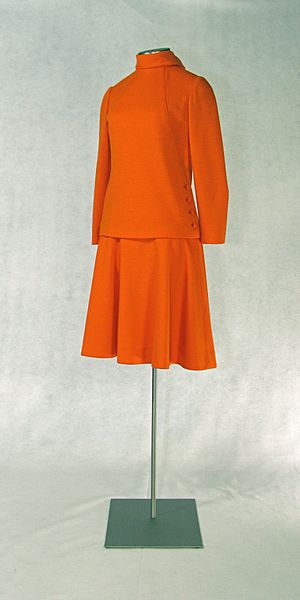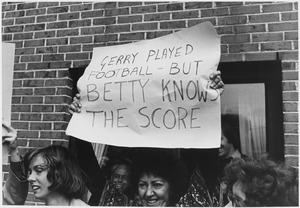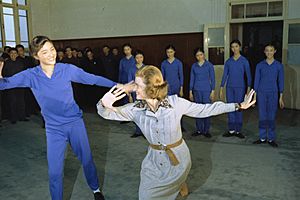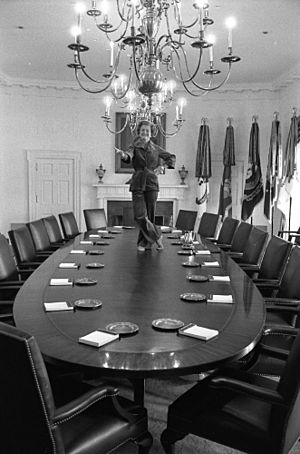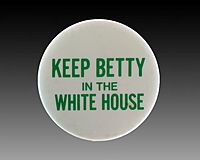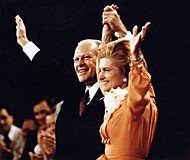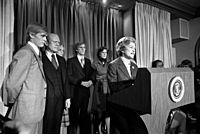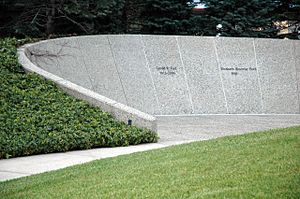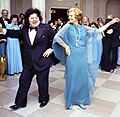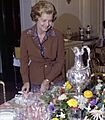Betty Ford facts for kids
Quick facts for kids
Betty Ford
|
|
|---|---|

Official portrait, 1974
|
|
| First Lady of the United States | |
| In role August 9, 1974 – January 20, 1977 |
|
| President | Gerald Ford |
| Preceded by | Pat Nixon |
| Succeeded by | Rosalynn Carter |
| Second Lady of the United States | |
| In role December 6, 1973 – August 9, 1974 |
|
| Vice President | Gerald Ford |
| Preceded by | Judy Agnew |
| Succeeded by | Happy Rockefeller |
| 1st Chairwoman of the Betty Ford Center | |
| In office October 4, 1982 – January 25, 2005 |
|
| Preceded by | Position established |
| Succeeded by | Susan Ford Bales |
| Personal details | |
| Born |
Elizabeth Anne Bloomer
April 8, 1918 Chicago, Illinois, U.S. |
| Died | July 8, 2011 (aged 93) Rancho Mirage, California, U.S. |
| Resting place | Gerald R. Ford Presidential Museum |
| Political party | Republican |
| Spouses | |
| Children | |
| Signature |  |
Elizabeth Anne Ford (born Bloomer; formerly Warren; April 8, 1918 – July 8, 2011) was the First Lady of the United States from 1974 to 1977. She was the wife of President Gerald Ford. As First Lady, she was very involved in social issues. She became known as a politically active presidential spouse. Betty Ford also served as the Second Lady of the United States from 1973 to 1974. This was when her husband was Vice President.
During her husband's time as president, she was very popular. Many saw her as an important First Lady. Ford was famous for helping people learn about breast cancer. She had a mastectomy in 1974. She also strongly supported the Equal Rights Amendment (ERA). She was a leader in the women's rights movement. She was known for speaking openly about important topics. These included feminism, equal pay, the ERA, and gun control. Historians often say she was one of the bravest American First Ladies.
Even after leaving the White House, Ford remained very influential and liked. She was often in the top ten of Gallup's "most admired woman poll" until 1991. She received the Presidential Medal of Freedom in 1991 from George H. W. Bush. In 1998, she and President Ford were given the Congressional Gold Medal.
Contents
Early Life and Dance Career
Betty Ford was born Elizabeth Anne Bloomer in 1918 in Chicago, Illinois. She was the third child and only daughter of Hortense and William Stephenson Bloomer Sr. Her father was a traveling salesman. She was called Betty as a child.
Betty grew up in Grand Rapids, Michigan. She went to Central High School. When she was eight, her mother enrolled her in dance classes. Betty loved to dance and wanted to make it her career. At 14, she started modeling clothes. She also taught popular dances like the foxtrot to earn money. This was during the Great Depression. She also worked with children who had disabilities. She even started her own dance school while in high school.
When Betty was 16, her father died. Her family lost their main source of income. Her mother became a real estate agent to support them. Her mother's actions helped shape Betty's views on equal pay and gender equality.
In 1936, after high school, Betty wanted to study dance in New York City. Her mother preferred she stay closer to home. So, Betty attended the Bennington School of Dance in Vermont for two summers. She studied with famous choreographers like Martha Graham. In 1940, she moved to New York City. She worked as a fashion model to pay for her dance studies. She even performed with the Martha Graham Dance Company at Carnegie Hall.
Betty's mother wanted her to return home. They agreed she would come back for six months. If she still wanted to go back to New York, her mother would not stop her. But Betty became busy with life in Grand Rapids and stayed. She worked at a local department store called Herpolsheimer's. She also taught dance to children, including those with visual impairment and hearing loss. She also taught African American children.
First Marriage and Challenges
In 1942, Elizabeth Bloomer married William G. Warren. He worked in insurance sales. They moved often because of his jobs. Betty worked in different places, including a department store and a frozen food company. After three years, she felt their marriage was not working. She wanted to have a family. William was a diabetic and had poor health. When she decided to file for divorce, he fell into a coma. She paused the divorce and supported him for two years while he recovered. This experience further showed her the unfairness of pay differences for the same work. They divorced in 1947.
Marriage to Gerald Ford and Family Life
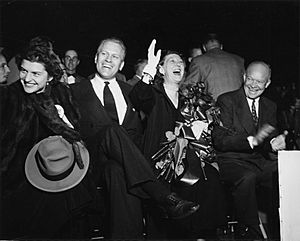
In 1947, Betty met Gerald Ford. He was a lawyer and World War II veteran. He was planning to run for the United States House of Representatives. They married on October 15, 1948, in Grand Rapids. Gerald Ford was in the middle of his campaign. He asked her to delay the wedding until just before the election. He was unsure how voters would feel about him marrying a divorced former dancer. For their honeymoon, they went to a college football game. Then they attended a campaign rally for Republican presidential candidate Thomas Dewey. The Fords were married for 58 years until Gerald Ford's death.
Betty and Gerald Ford had four children: Michael (born 1950), John (Jack; born 1952), Steven (born 1956), and Susan (born 1957).
The Fords lived in Washington, D.C., after Gerald was elected. Later, they moved to Alexandria, Virginia. Gerald Ford wanted to become Speaker of the House. This meant he traveled a lot to raise money and campaign for other Republicans. He was away from home about half the year. This meant Betty had a big job raising their children. She never spanked her children. She believed there were better ways to teach discipline.
Betty was active in her community. She was a parent-teacher association member, a Sunday school teacher, and a Cub Scout "den mother". She drove her children to their activities, like baseball games and dance classes. She also helped her husband's political career. She went with him to events and on some trips abroad. She also posed for newspaper photos and modeled clothes for charity fashion shows. She volunteered for local charities, like the Alexandria Cancer Fund Drive.
Betty's busy life was hard on her. In 1964, she had a pinched nerve in her neck. This led to other health issues, including muscle spasms and arthritis. The stress of her husband's demanding career also grew. In 1965, Betty had a difficult time and sought professional help. With support from her family, she was able to continue her busy life.
In 1972, Betty went with her husband on a trip to mainland China. That same year, her husband thought about retiring from Congress in 1977. This made Betty very happy. He felt it was unlikely he would become Speaker of the House.
Second Lady of the United States (1973–1974)
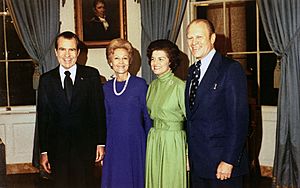
Spiro Agnew resigned as Vice President on October 10, 1973. Two days later, President Richard Nixon chose Gerald Ford to be the new Vice President. Betty Ford attended her husband's confirmation hearings. During the hearings, Gerald Ford was asked about psychiatric care. Betty Ford openly told the news media that she had received such care. She explained that her husband's visits were for her, not for him. Gerald Ford became Vice President on December 6, 1973. Betty Ford held the bible as he took his oath. She then became the Second Lady of the United States.
Soon after, Betty helped create the Republican Women's Federal Forum. This group brought together political spouses and women in government. They discussed party activities and new laws.
As Second Lady, Betty Ford focused on promoting the arts. In April 1974, she took her first official solo trip. She visited Georgia and Tennessee to promote the "ARTRAIN." This was a traveling art exhibit on railway cars. Betty Ford was the main national supporter of this project. Her honest way of speaking was well-received by the news media. She met Georgia Governor Jimmy Carter and his wife Rosalynn Carter on this trip. The Carters would later become the Fords’ successors in the White House.
On May 31, 1973, Betty Ford gave her first major speech. She spoke at the Westminster Choir College graduation. This was different from First Lady Pat Nixon, who rarely gave formal speeches. Betty Ford also started wearing more designer clothing. Besides the arts, she also focused on helping people with disabilities.
In June 1974, Betty Ford attended the funeral of Alberta Williams King. She was the assassinated mother of civil rights leader Martin Luther King Jr.. Other Nixon administration officials did not attend. Betty Ford was the only person there not directly involved in the civil rights movement, except for Governor Jimmy Carter. Her attendance showed a difference from the administration's views. She believed it was important for the government to show concern. She also supported federally-funded child daycare, which the Nixon administration opposed.
By July 1974, Betty Ford had a very busy schedule. Magazines like Vogue and Ladies Home Journal planned to feature her. Her husband, as Vice President, was campaigning a lot for the 1974 midterm elections. Betty sometimes joined him on the campaign trail.
Both Betty and Gerald Ford did not comment on rumors about President Nixon leaving office due to the Watergate scandal. Betty did say she would make any sacrifices needed for her husband to do his duty. But she also said it would be very hard if a president was forced out of office. She also publicly showed friendship toward First Lady Pat Nixon.
First Lady of the United States (1974–1977)

On August 9, 1974, President Nixon resigned. He was facing possible impeachment. Gerald Ford became the 38th President of the United States. Betty Ford became the First Lady of the United States. Just like at his Vice Presidential swearing-in, Betty Ford held the Bible as he took his oath. In his speech, Gerald Ford said, "I am indebted to no man and only one woman, my dear wife, Betty, as I begin this very difficult job."
High Popularity
Betty Ford was very popular with the American public. Her approval rating sometimes reached 75%. She was often more popular than her husband. During his 1976 presidential campaign, she joked, "I would give my life to have Jerry have my poll numbers." This shows that First Ladies are often more popular than their presidential husbands.
Advocacy for Women's Rights
As First Lady, Betty Ford was a strong supporter of women's rights. She was a key figure in the Women's Movement of the 1970s. Her active political role led Time to call her the country's "Fighting First Lady." In 1975, Time featured her as one of the "American Women" for their Person of the Year issue. On September 4, 1974, soon after becoming First Lady, she held a press conference. She said she wanted to be remembered "in a very kind way; also as a constructive wife of a president."
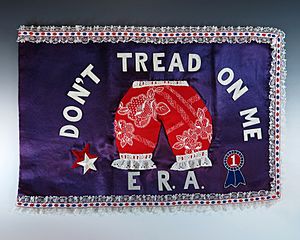
Betty Ford strongly supported the proposed Equal Rights Amendment (ERA). She publicly declared her support in her first press conference. She urged state lawmakers to approve the amendment. She used phone calls, letters, and telegrams to lobby for the ERA.
Ford also convinced her husband to sign an executive order in 1975. This order created the National Commission on the Observance of International Women's Year. She also tried to persuade him to appoint the first woman to the Supreme Court of the United States. She also wanted him to choose a woman as his running mate in the 1976 election, but these efforts were not successful. However, she took credit for the appointment of Carla Anderson Hills as Secretary of Housing and Urban Development.
Some conservative critics did not like Ford's involvement in political issues. Phyllis Schlafly said Ford was acting improperly by getting involved in state matters. Some women protested outside the White House with signs saying, "Betty Ford, Get Off the Phone." On June 30, 1976, Ford attended an exhibit about Revolutionary War-era women. She was booed by anti-ERA protesters when she said, "This exhibit about neglected Americans should give us strength and courage to seek equal rights for women today."
Supporting the Arts
As First Lady, Betty Ford was a champion of the arts. She convinced her husband to give the Presidential Medal of Freedom to choreographer Martha Graham in 1976. She also received an award from Parsons The New School for Design for her style.
White House State Dinners

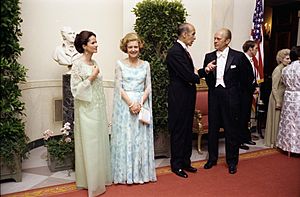
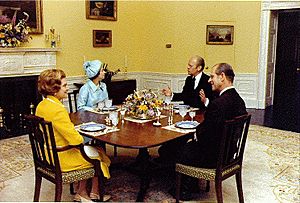
Even though her husband was president for only about two and a half years, he hosted 33 state dinners. This is the fifth highest number for any U.S. president. The first dinner happened just a week after Ford became president. It was for King Hussein of Jordan on August 16, 1974. Betty Ford found out about this dinner and her role in planning it within 24 hours of her husband becoming president. She brought back dancing as an activity at White House state dinners. The Nixons had stopped dancing at these dinners. At the Ford state dinners, the president and first lady always started the dancing. Dancing often continued past midnight.
The Fords invited a wide variety of guests to their state dinners. This included famous people from the entertainment world. Their children often attended these dinners too.
In their last year in the White House, the Fords hosted eleven state dinners. Many foreign leaders wanted to visit the U.S. during the Bicentennial celebrations. Betty Ford decided to put up a tent in the White House Rose Garden for some dinners. For these tent dinners, the parties, entertainment, and dancing were still held inside the White House.
One of the most famous state dinners was on July 7, 1976. It honored Queen Elizabeth II and Prince Philip. This dinner was part of the American bicentennial celebrations. It was held in a tent on the South Lawn of the White House.
Betty Ford said about the dinners, "From the beginning, Jerry and I tried to make the White House a place where people could have fun and enjoy themselves. Most of all we wanted the state dinners to express the very best about America, particularly during the bicentennial year."
Ford liked to serve dishes like wild rice, Columbia River salmon, soufflé, and flambé. The state dinners she planned tried to show off American ingredients. By late 1974, Ford only served American-made wine at state dinners. The first time a Michigan wine was served at a White House state dinner was on November 12, 1974. This was for the Austrian Chancellor Bruno Kreisky.
Diplomatic Travels
Betty Ford went with her husband on several trips to other countries. These included China, Poland, Romania, and Yugoslavia.
She did not take any solo trips abroad as First Lady. She is the most recent First Lady not to have done so. However, this was not unusual. The first First Lady to travel alone was Eleanor Roosevelt in 1942. Other First Ladies, like Lady Bird Johnson, also did not take solo trips.
During the Fords' 1976 trip to mainland China, Betty Ford joined dance students at an art college. Photos of her dancing were widely published in American newspapers. This made Betty Ford almost as famous as President Ford in the news.
Charitable Work
Betty Ford supported many charities as First Lady. She helped raise money for the Hospital for Sick Children in Washington, D.C. Most of its patients were African American. She also raised money for No Greater Love. This group helped children of Vietnam War soldiers who were missing in action or prisoners of war. She was the honorary president of the National Lupus Foundation. She saw lupus as a disease that affected women but got little public attention. She also focused on charities that helped children with special needs.
Role in the 1976 Presidential Campaign
In November 1975, news reports said that Betty Ford's popularity was growing. Her husband's advisors, who had worried her outspoken comments might hurt him, now wanted her to play a bigger role in the 1976 presidential campaign. Betty Ford became very important in the campaign. She made appearances and gave speeches across the United States.
Betty Ford was seen as a symbol of liberal Republicanism. Her views were often different from the more conservative parts of the Republican Party. Many of her husband's supporters wore campaign buttons. Some said, "Betty's Husband for President in '76." Others said, "Keep Betty in the White House." This showed how much people liked Betty Ford.
Betty campaigned actively in both the primary elections and the general election. Many of her views were similar to, or even more liberal than, Rosalyn Carter's. Rosalyn Carter was the wife of Jimmy Carter, her husband's opponent.
During the primaries, Betty Ford recorded radio advertisements for the campaign. She also traveled to Iowa before its caucus. She gave a speech for the president, calling herself his political partner. The campaign made sure to send Betty Ford to states with more liberal or moderate voters.
For the general election, Betty Ford went on speaking tours. She visited western states like California and Texas. She also visited midwestern states like Illinois and Michigan.
The intense campaigning affected Betty Ford's health. Her pinched nerve problems returned. But she continued with her planned campaign schedule.
After Gerald Ford lost to Jimmy Carter in the 1976 presidential election, Betty Ford gave his concession speech. He had lost his voice from campaigning. This was the only time a major U.S. presidential candidate's spouse has given their concession speech for them.
Some people believed Betty Ford's popularity helped her husband get support from liberal and moderate voters. But it might have also made some conservative Republicans less likely to vote for him.
-
Campaign button in support of President Ford's 1976 presidential campaign with the phrase "Keep Betty in the White House"
-
Betty and Gerald Ford onstage at the 1976 Republican National Convention
Life After the White House
After leaving the White House in 1977, Betty Ford continued to be active in public life. She founded the Betty Ford Center. She also stayed involved in women's issues. She gave many speeches and helped charities raise money. Many of her most important contributions came after her time as First Lady.
In 1977, the Fords moved to Rancho Mirage, California.
In March 1977, Betty Ford signed a deal with NBC News. She would appear in two news specials and contribute to Today. She and her husband also signed a deal to write their memoirs. In June 1977, Ford spoke at the Arthritis Association Convention. In September, she traveled to Moscow for a TV show and to host The Nutcracker. In November 1977, Ford attended the opening of the National Women's Conference in Houston, Texas.
Continuing Women's Movement Work
Betty Ford remained a strong leader in the feminist movement after her husband's presidency. She continued to advocate for the Equal Rights Amendment (ERA). In 1977, President Jimmy Carter appointed her to the second National Commission on the Observance of International Women's Year. That same year, she joined First Ladies Lady Bird Johnson and Rosalynn Carter at the National Women's Conference in Houston. There, she supported plans to improve the status of American women. Throughout her life, Ford continued to speak out for equal pay for women, breast cancer awareness, and the ERA. She was also an active member of the Junior League.

Ford continued to push for the ERA's approval. In November 1977, she and First Lady Rosalynn Carter worked together for its approval in Houston. In 1978, the deadline for the ERA was extended. This was partly due to a large march in Washington, D.C. Prominent feminist leaders, including Ford, led the march. In 1981, Ford was named co-chair of the ERA Countdown Campaign. She visited states like Illinois, where the ERA had a chance of passing. On October 12, 1981, Ford spoke at an ERA rally on the National Mall. The amendment did not get enough states to approve it.
Other Important Causes
Betty Ford also addressed the issue of HIV/AIDS during the HIV/AIDS crisis. She became involved with the Los Angeles AIDS Project. In 1985, she received their "Commitment to Life Award."
Ford supported gay and lesbian causes. She spoke out against discrimination in the U.S. military.
In 1985, Ford received the Award for Greatest Public Service Benefiting the Disadvantaged. This is an annual award from the Jefferson Awards. That same year, she received the Golden Plate Award from the American Academy of Achievement. Her husband, President Ford, presented it to her.
In 1987, Ford had quadruple coronary bypass surgery and recovered well.
In the early 1990s, Ford admired First Lady Hillary Clinton. She praised Clinton for taking an active role in policy. Clinton led the Clinton health care plan.
In 1987, Ford was added to the Michigan Women's Hall of Fame. On November 18, 1991, President George H. W. Bush gave her the Presidential Medal of Freedom. In 1999, she and President Ford both received Congressional Gold Medals. They also received a Golden Palm Star on the Palm Springs Walk of Stars in 1999. In 2000, the Lasker Foundation gave Ford its Mary Woodard Lasker Public Service Award. On May 8, 2003, Ford received the Woodrow Wilson Award for her public service.
In their later years, the Fords lived in Rancho Mirage, California, and Beaver Creek, Colorado. President Ford died on December 26, 2006, at age 93. Despite her own health issues, Betty Ford traveled across the country for his funeral events. After his death, she continued to live in Rancho Mirage. Her health declined, and she mostly stopped public appearances after 2007.
Death and Burial
Betty Ford died from natural causes on July 8, 2011. She was 93 years old. She passed away at Eisenhower Medical Center in Rancho Mirage. Ford left $500,000 to the Betty Ford Center.
Funeral services were held in Palm Desert, California, on July 12, 2011. More than 800 people attended. This included former president George W. Bush, then-First Lady Michelle Obama, and then-Secretary of State Hillary Clinton. Former First Ladies Rosalynn Carter and Nancy Reagan were also there. Rosalynn Carter gave a speech.
On July 14, a second service was held in Grand Rapids, Michigan. Speeches were given by Lynne Cheney, Richard Norton Smith, and Ford's son Steven. Former president Bill Clinton, former vice president Dick Cheney, and former first lady Barbara Bush attended. Lynne Cheney noted that July 14 would have been Gerald Ford's 98th birthday. After the service, Betty Ford was buried next to her husband at the museum grounds.
In July 2018, a statue of Betty Ford was revealed outside the Gerald R. Ford Presidential Museum in Grand Rapids, Michigan.
Awards and Special Recognitions

In 1975, Time magazine named "American women" as its "Time Person of the Year." Betty Ford was one of eleven women featured to represent American women.
Other honors and awards she received include:
- 1975 National Woman's Party “Alice Paul Award”
- 1975 Philadelphia Association for Retarded Citizens "Humanitarian Award"
- 1975 National Art Association "Distinguished Woman of the Year Award"
- 1975 Anti-Defamation League Women's Division "Rita V. Tishman Human Relations Award"
- 1975 Florists' Transworld Delivery "Golden Rose Award"
- Order of the Pleiades (from Shah Mohammad Reza Pahlavi of Iran)
- 1976 Parsons Annual Critics Awards Show "Parsons Award"
- 1978 Eleanor Roosevelt Humanities Award
- 1981 Friends of Hebrew University "Scopus Award"
- 1982 American Cancer Society "Hubert Humphrey Inspirational Award"
- 1983 Susan G. Komen Foundation "Komen Foundation Award"
- 1984 National Arthritis Foundation "Harding Award"
- 1985 Jefferson Awards for Public Service "Award for Greatest Public Service Benefiting the Disadvantaged"
- 1985 American Academy of Achievement "Golden Plate Award"
- 1985 AIDS Project Los Angeles "Commitment to Life Award"
- Inducted into the Michigan Women's Hall of Fame in 1987
- 1987 International Center for the Disabled "Freedom of Human Spirit Award"
- 1988 College of Communication at the University of Texas "McGovern Distinguished Leadership Award"
- "Citation of Layman for Distinguished Service" from the American Medical Association in 1979
- Presidential Medal of Freedom (from President George H. W. Bush in 1991)
- 1991 International Women's Forum "Hall of Fame Award"
- 1995 Samaritan Institute "National Samaritan Award"
- 1995 Columbia Hospital for Women "Breast Cancer Awareness Lifetime Achievement Award"
- 1996 Bob Hope Classic Ball awardee
- 1997 American Institute for Public Service "Jefferson Award"
- 1997 Michigan Women's Foundation "Women of Achievement & Courage" award
- 1997 Women's International Center "Living Legacy Award"
- 1998 Common Wealth Award of Distinguished Service
- 1998 Ronald McDonald House Charities "Award of Excellence"
- Congressional Gold Medal in 1999 (with Gerald Ford)
- Golden Palm Star on the Palm Springs Walk of Stars (with Gerald Ford in 1999)
- 1999 American Hospital Association "C. Everett Koop Health Award"
- 2000 Lasker Foundation Mary Woodard Lasker Public Service Award
- 2003 Smithsonian Institution Woodrow Wilson Center "Woodrow Wilson Award"
- National Women's Hall of Fame (added after her death in 2013)
Places and Things Named for Betty Ford
- Betty Ford Cancer Research Center at Cedars-Sinai Hospital in Los Angeles, California (named in 1978)
- Betty Ford Center for Comprehensive Breast Diagnosis at Columbia Hospital for Women in Washington, D.C. (named in 1980; hospital is now closed)
- Betty Ford Alpine Gardens in Vail, Colorado
- Susan G. Komen Foundation "Betty Ford Award"
See also
 In Spanish: Betty Ford para niños
In Spanish: Betty Ford para niños
- List of breast cancer patients according to occupation
- List of first ladies of the United States
- Second-wave feminism
Images for kids
-
Ford sits in the White House Solarium with Morley Safer before filming her August 1975 60 Minutes interview with him.
-
Ford in November 1975, sitting at the Hay–Adams Hotel with television producer Ed Weinberger and actress Mary Tyler Moore during the filming of Ford's cameo appearance on The Mary Tyler Moore Show
-
President Ford sits at Betty's bedside at Bethesda Naval Hospital on October 2, 1974 as she recovers from her mastectomy
-
Ford dancing with comedian Marty Allen in the Entrance Hall of the White House of the White House during a September 21, 1976 state dinner in honor Liberian President William Tolbert
-
Ford and Social Secretary Maria Downs give the media a tour of the tent erected in the South Lawn for the July 1976 state dinner honoring Queen Elizabeth II and Prince Philip of Great Britain
-
Ford and Social Secretary Maria Downs inspect centerpiece sculptures designed by Frederic Remington and Charles Russell ahead of an October 1975 state dinner honoring Anwar Sadat, the president of Egypt
-
The Fords escort Japanese Emperor Hirohito and Empress Kōjun down the Cross Hall towards the East Room during an October 1975 state dinner honoring the Japanese royals
-
The Fords welcome President-elect Jimmy Carter and his wife Rosalynn Carter to the White House on November 22. 1976, during the presidential transition
-
Ford and others applaud in the gallery during the 1977 State of the Union Address on January 19, 1977, the Fords’ final full-day in the White House
-
The incoming and outgoing first and second couples pose for a photograph at the White House on the day of the inauguration of Jimmy Carter. L-R:Vice President-elect Walter Mondale, incoming second lady Joan Mondale, outgoing Vice President Nelson Rockefeller, outgoing second lady Happy Rockefeller, Betty Ford, Gerald Ford, incoming first lady Rosalynn Carter, and President-elect Carter
-
The Fords meet with President Ronald Reagan and First Lady Nancy Reagan in the White House Oval Office in March 1981
-
Betty Ford is awarded the nation's highest civilian honor, the Presidential Medal of Freedom, by President George H. W. Bush, 1991. First Lady Barbara Bush holds the medal.
-
Ford with other U.S. First Ladies at the November 1991 opening of the Ronald Reagan Presidential Library. Seated (l–r): Lady Bird Johnson, Pat Nixon, Rosalynn Carter, Ford; Standing (l–r): Nancy Reagan, Barbara Bush
-
President Bill Clinton speaks with the Fords at the White House ceremony awarding the at a 1999 Presidential Medal of Freedom ceremony
-
Ford with other U.S. First Ladies at the 1994 National Garden Gala, which was themed "A Tribune to America's First Ladies". L–R: Nancy Reagan, Ladybird Johnson , Hillary Clinton, Rosalyn Carter, Ford, Barbara Bush
-
The Fords post for a photograph with three other U.S. first couples (George H. W. and Barbara Bush, Bill and Hillary Clinton, Jimmy and Rosalynn Carter) during at the 2000 White House Historical Association Dinner
-
The Fords with President George W. Bush and First Lady Laura Bush at the White House in 2003 at a celebration President Ford's 90th birthday
-
Betty Ford with her husband and President George W. Bush on April 23, 2006
-
Ford leans over President Ford's coffin during memorial services for him held December 30, 2006 in the United States Capitol rotunda as part of the his state funeral




